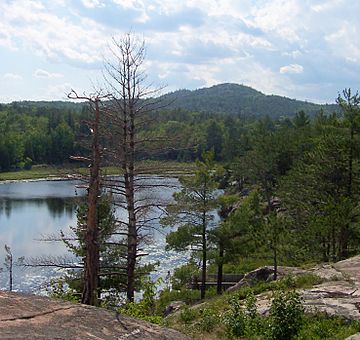Huron Mountains facts for kids
Quick facts for kids Huron Mountains |
|
|---|---|

Hogback Mountain (1,220 ft) in the Presque Isle Tract, a park within the Huron Mountain Range
|
|
| Highest point | |
| Peak | Mount Arvon |
| Elevation | 1,979 ft (603 m) |
| Geography | |
| Country | United States |
The Huron Mountains are a beautiful mountain range. They are found in the Upper Peninsula of Michigan, a state in the United States. These mountains are mostly in Marquette and Baraga counties. They stand tall overlooking Lake Superior.
The highest point in the Huron Mountains is Mount Arvon. It reaches 1,979 feet (603 m) above sea level. This makes it the highest spot in all of Michigan! Close by is Mt. Curwood, which is Michigan's second highest mountain. It is 1,978 feet (603 m) tall and also part of the Huron Mountains.
Mountain Geology: How They Formed
These mountains are very old. They are what's left of much taller peaks. The rocks here formed during the Precambrian period, which was billions of years ago. Over time, the land was pushed up and then worn down by weather.
You can see large rocks made of granite and metamorphic rocks. These rocks show signs of being shaped by glaciers more recently. Geologically, this area is part of the Canadian Shield. This is a huge, ancient rock formation that covers much of eastern Canada and parts of the northern U.S.
The Huron Mountains get a lot of snow. This is because of something called lake-effect snow from Lake Superior. There are no official weather stations right in the mountains. But, the yearly snowfall often goes over 200 inches (510 cm) across the whole range. Some higher areas might even get over 250 inches (640 cm) of snow each year. A nearby town called Herman usually gets about 236 inches (600 cm) of snow per season.
Nature and Animals: The Ecology
The Huron Mountains are known for their special plant life. They have what is called boreal vegetation. This means they have plants that grow in cold, northern areas. The region also has many different kinds of habitats that are very clean and untouched.
This area is home to one of the biggest parts of undisturbed old-growth forest in the upper Great Lakes region. An old-growth forest is one that has grown naturally for a very long time. It has not been cut down or changed much by people. Other similar forests are in the Porcupine Mountains and the Boundary Waters Canoe Area.
The forests on the higher parts of the mountains have many hemlock trees. They also have northern hardwood trees like maple and birch. On the steep slopes and mountain ridges, you will find forests with pine and oak trees.
Many animals live in this area. You might see wolves, moose, and coyotes. There are also cougars, fishers, and martens. Other animals include mink, white-tailed deer, and both gray and red foxes. Porcupines, black bears, river otters, and beavers also call the Huron Mountains home.
Protecting the Mountains: Conservation
The Huron Mountains have stayed wild and beautiful for a long time. This is largely thanks to a group called the Huron Mountain Club (HMC). This club owns a big piece of land in the mountains. This land includes part of the Salmon Trout River.
The club asked a famous nature expert, Aldo Leopold, to create a plan to protect the area. However, this private club also limits who can visit its land. This can be a bit sad for people who love white water rafting. The Salmon Trout River is said to be one of the best rafting rivers in Michigan.
Even famous people like Henry Ford had to wait to join the club. To gain favor with the club, Ford stopped a plan to build a highway, M-35, through the mountains. After he became a member, Ford had a fancy cabin built for himself in 1929.
The Huron Mountain Wildlife Foundation also helps protect the area. They support scientific research about nature in the region. This includes studies on the lands owned by the HMC.
In the late 1950s, people thought about making the Huron Mountains a national park. But the Huron Mountain Club was very powerful. They helped stop the idea of it becoming a national park.




